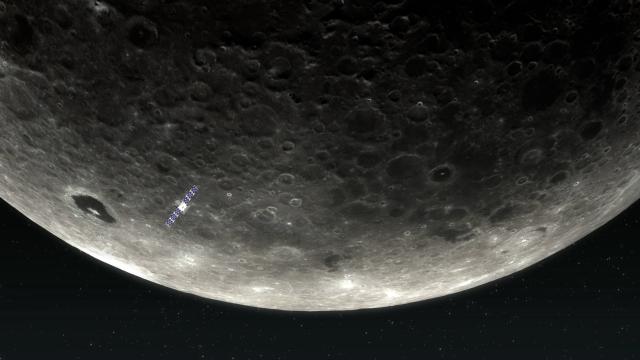An important milestone has been reached in the newly launched CAPSTONE mission, as the tiny probe, moving in excess of 38,624 km per hour, has escaped low Earth orbit and begun its four-month trek to the Moon.
CAPSTONE, short for Cislunar Autonomous Positioning System Technology Operations and Navigation Experiment, bid farewell to low Earth orbit earlier this morning, according to NASA. The 55-pound (25 kilograms) cubesat is now journeying to the Moon, where it will enter into a near rectilinear halo orbit (NRHO) on November 13.
This is the same orbit planned for the upcoming Lunar Gateway; the new mission meant to evaluate the suitability of NRHO on a smaller scale. Once built, and as part of NASA’s Artemis program, Lunar Gateway will be used to support a long term and sustainable human presence at and around the Moon.
CAPSTONE launched from New Zealand atop a Rocket Lab Electron rocket on June 28. The cubesat had been orbiting Earth while attached to Rocket Lab’s Photon upper stage. A total of seven manoeuvres were performed over the course of six days, during which CAPSTONE’s orbit was steadily lifted. CAPSTONE eventually reached a maximum distance of 810,000 miles (1.3 million kilometers) from Earth, which is more than three times the Earth-Moon distance. Photon released its payload once the pair reached 39,429 km per hour (39,500 km/hr) — the speed required for CAPSTONE to escape Earth orbit.
CAPSTONE is now on a ballistic lunar transfer trajectory to the Moon, a convoluted — but efficient — trajectory in which the probe will follow “dynamic gravitational contours in deep space,” as NASA explains:
Expending little energy, CAPSTONE will cruise along these contours punctuated by a series of planned trajectory correction manoeuvres. At critical junctures, CAPSTONE’s team at Advanced Space’s mission operations centre will command the spacecraft to fire its thrusters to adjust course. Terran Orbital Corporation in Irvine, California, designed and built CAPSTONE and developed novel technology that allows the spacecraft to execute manoeuvres while maintaining control of the spacecraft on thrusters only.
When CAPSTONE catches up to the Moon, its approach will be perfectly aligned for NRHO insertion, the crux of its route. While going 6,116 km per hour [6,116 km/hr], it will perform its delicate, precisely timed propulsive manoeuvre to enter orbit, like a flying trapeze artist who jumps from one arc to another with a decisive, acrobatic motion.
NRHO represents an ideal gravitational sweet spot for Lunar Gateway. Here, the pull of gravity from the Earth and Moon interact to enable a near-stable orbit, “allowing physics to do most of the work of keeping it in orbit around the Moon,” according to NASA. CAPSTONE will spend six months in NRHO, during which time it will travel to within 2,100 miles (3,400 km) of the Moon’s north pole on its near pass and 47,000 miles (76,000 km) from the south pole at its most distant.
In addition, CAPSTONE will test a navigational system in which the probe will measure its location relative to NASA’s Lunar Reconnaissance Orbiter and without the benefit of ground stations on Earth.
More: Astronauts Can Suffer a Decade of Bone Loss During Months in Space.
